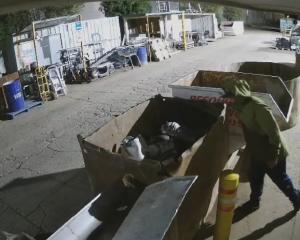Contractors have resumed removing the rot from Christchurch's fire-damaged wastewater treatment plant after a mechanical fault ground all work to a halt earlier this week.
Crews must scoop 26,000 cubic metres of material from the filters, 1000 of which has already been chipped, compacted and trucked to the Kate Valley landfill.
A ramp leads to the top of one of the filters, where a digger is parked ready to scoop the next load of media from behind its three-storey concrete walls.
Contractors have also dropped a smaller digger inside the trickling filter to excavate the material from within and push it closer to the edge.

"There are two possibilities - one is it's okay and we retain that housing for future use - the other is it's completely damaged and we can just punch through the side and take everything out," she said.
"These are massive structures and there's an enormous amount of media in there."
Contractors were working on the roof of the plant when the blaze broke out last November, but Beaumont said she could not make any comment about the cause of the fire.
"I've seen some of the investigation reports," she said.
"There are insurance implications and legal implications. It's complicated when you have a number of contractors on site and a number of insurance agencies involved."
The council is investigating whether discolouration and dark stains on nearby homes are linked to the plant, but it is yet to receive the results of test samples taken from paint.

Beaumont said she did not believe payments should be extended to households city-wide.
"I don't think it should be the whole of Christchurch. While you can detect the odour right across the city, it's nothing like the level of odour and the intensity of the odour, the frequency at which people are smelling it in the immediate neighbourhood," she said.
The council was trying to improve the quality of the effluent flowing into the plant's six oxidation ponds by converting two of the plant's four clarifiers into aeration basins to churn more oxygen into the wastewater.

Beaumont said the smell from the ponds had worsened in the last month.
"In May they started to deteriorate and they're continuing to deteriorate as the weather gets colder. That's why we want to get these aeration basins up and running over the next few weeks and improve the quality of the wastewater that's going into the ponds."
Gases including hydrogen sulphide have been detected in specialist air quality tests around the plant.
The council plans to order up to 10 hydrogen sulphide meters to constantly monitor the air quality in the area, the results of which will be measured against WorkSafe, World Health Organisation and Ministry for the Environment guidelines.




















